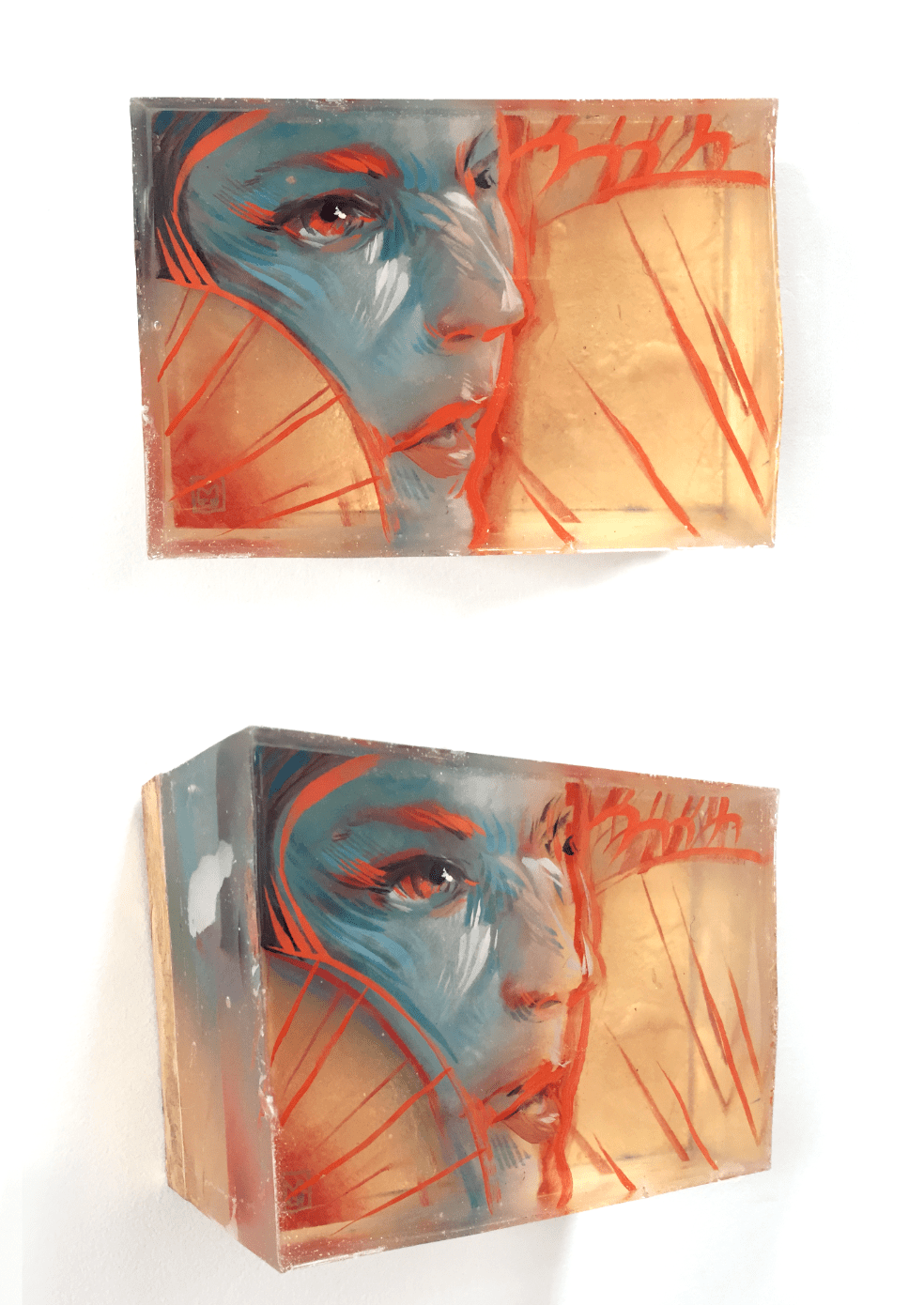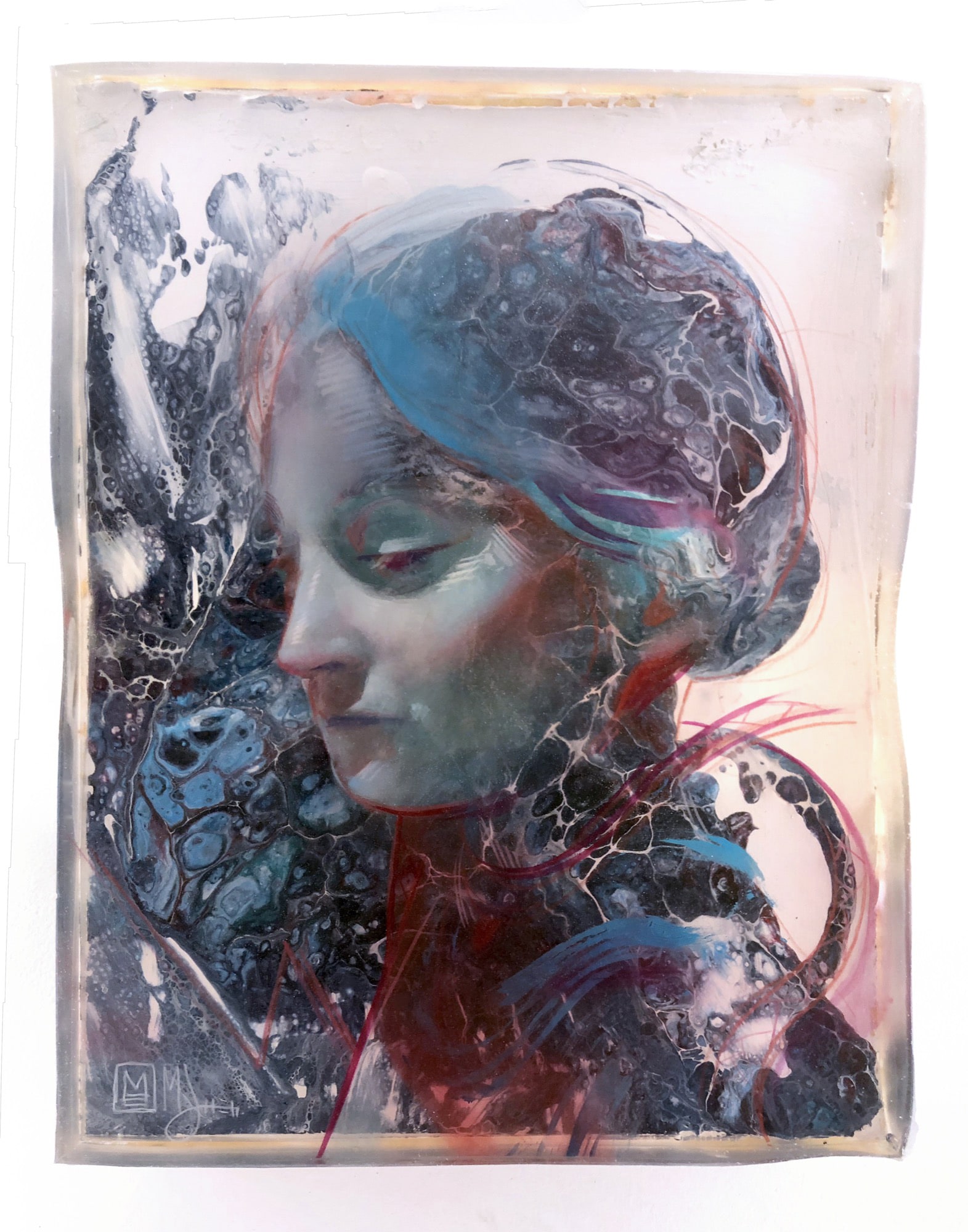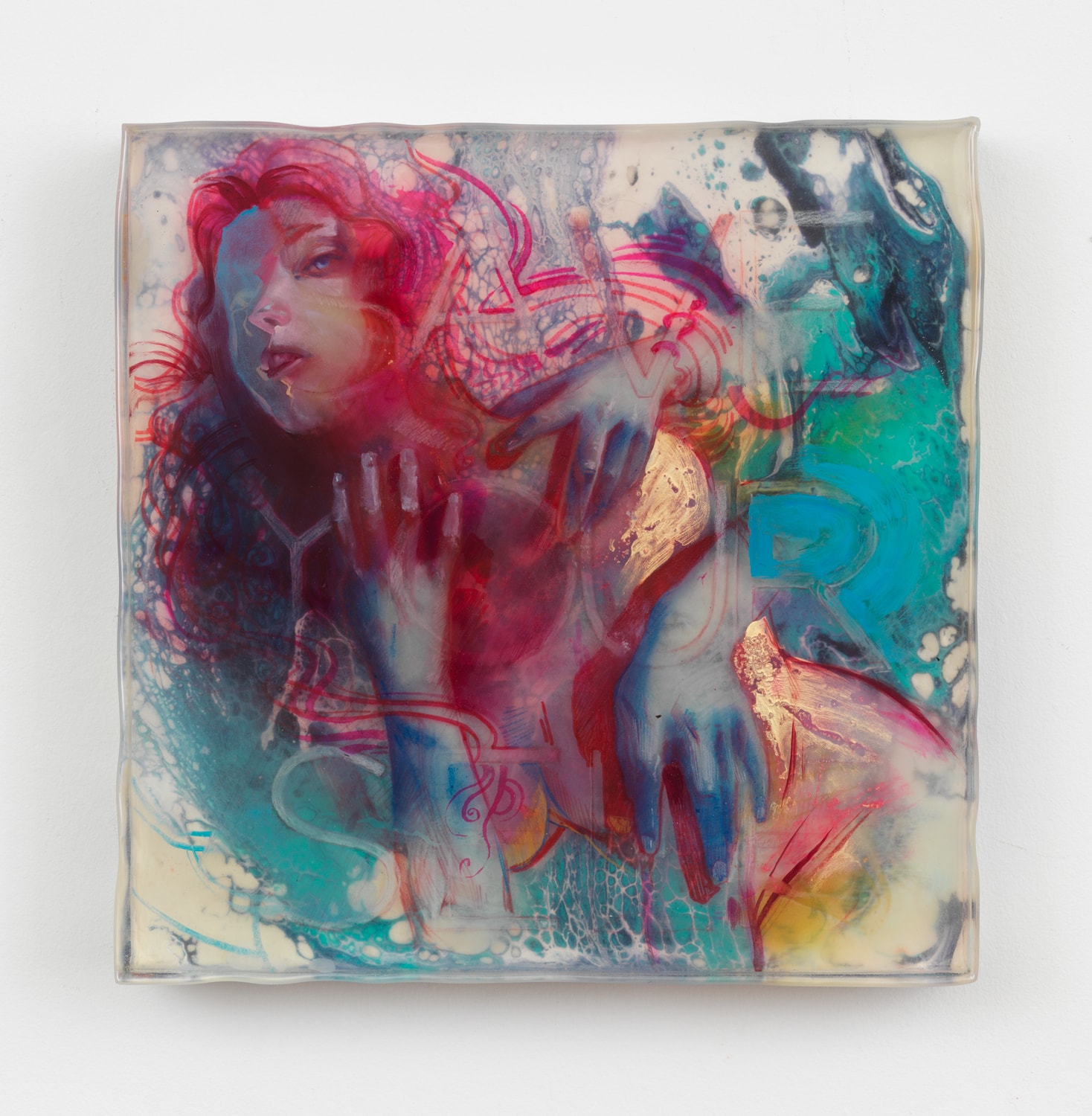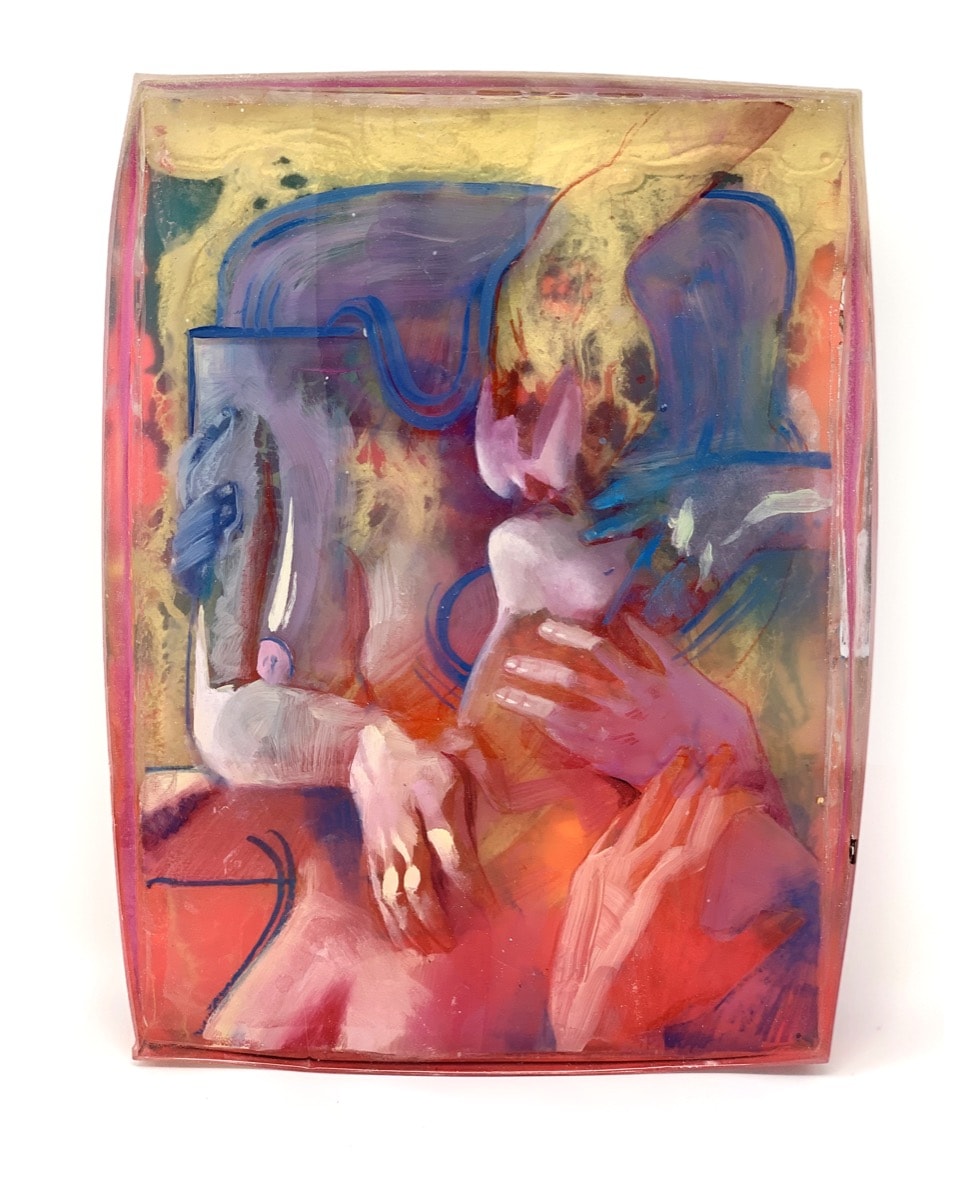Contemporary artist Marc Scheff. In short, Marc creates multi-dimensional resin portraits, examining the formation of individual identity and consciousness. Anchored in figurative draughtsmanship, he employs a complex layering process for each piece, incorporating poured resin, gold leaf, pencil and paint, offering viewers a literal window into the human psyche. Fresh off the heels of a successful run at Superfine LA, and a couple group exhibitions with REHS Contemporary and Corey Helford, Marc is gearing up for the NYC edition of Superfine during Frieze Week 2019.
Currently you’re preparing a new batch of portraits to be shown at Superfine New York. Can you talk a bit about what sets apart your latest series of resin portraits from previous work?
Research and depth, renewed vigor and risk-taking. There actually was a clear break in this body of work from my previous efforts. I felt like I had hit a plateau with materials and ideas. This happens occasionally, and I know it’s BS because there’s always more ideas. So when it happens, I look for a way to dig deeper. I have always felt connected to a message, artistically and politically, and I knew that I wanted that to get a little bit louder. Right now, I’m finding lots of inspiration in the German Expressionist movement, which also happens to feel very relevant politically. David Bowie, who is a constant beacon of inspiration in my life, found his own muse there and created a body of work after he moved to Berlin with Iggy Pop in 1976 (coincidentally the year I was born).
The visceral connection to emotional truth in that work, as well as the innovative use of materials, is one of the drivers for my new work.
Previously, you’ve mentioned that your artistic practice is based around two competing urges: exploration and mastery. How much of your work is plotted out ahead of time, and how much comes about organically?
I almost feel like it’s a no-no to say, but I freely admit that I plan things out. I just leave a lot of room and don’t plan every step. I have a few good strategies for dealing with inevitable surprises too. I actually like working with materials that don’t behave, and love to approach improvisation with intention. I know enough about what can and will go wrong, so there’s an outcome tree for each piece with which I’m comfortable. I’m also comfortable having pieces completely fail. My failsafe strategy is paint over and start over, so I can take risks.
Nuts and bolts: I have a few ways I produce work. Most work starts either in a thumbnail sketchbook, or in an experimental multi-media sketchbook. From there I bash reference material from photo shoots, and build up a comp in Photoshop. When I feel like I have enough to go on where I will definitely get into the kind of trouble I can get out of, I start work on a panel. After I work and pour a layer of resin, if I want to take bold steps, I usually try them digitally first, then let the paint fly again.
 You’ve stated that your love for draughtsmanship is at the core of your work, while ArtResin is the integral material that gives each work its definitive dimensionality. Can you discuss the synergy between these two seemingly unrelated concentrations?
You’ve stated that your love for draughtsmanship is at the core of your work, while ArtResin is the integral material that gives each work its definitive dimensionality. Can you discuss the synergy between these two seemingly unrelated concentrations?
One of the things that fascinated me about the layering of resin is how it reveals the process, it’s exposed, vulnerable, and it has to be honest. The final product reveals the steps along the way, you can see them. That feels edgy to me not just artistically, the idea that the process is exposed and the final result isn’t super clean and polished. Beyond art, I just think about how often we, in our day to day lives, hide our process, hide the messy bits. I love watching artists work to see what lies beneath. In my work, it’s all right there.
I also have a deep love for drawing. What led me to the resin work was a habit and practice of drawing every day. I would drop my kids off at school and stop at my local coffee shop and pull out my sketchbook and practice drawing from observation. If I didn’t have anything on the calendar, hours could go by without me noticing. These were the opposite of messy for me. They were slowly built to a finish that revealed very little about how I got there.
But the tension for me isn’t even around messy vs polished or exposed vs hidden. For me there’s a palpable tension around an expectation of what the work is supposed to look like. That idea really speaks to me. I have my own art heroes, I have exterior influences and inspiration, and I’m always chasing images in my own head. And my work won’t ever look like any of those things, so the back and forth between these two concentration perfectly supports my own oscillating thoughts around what a “good” outcome is.
I’m curious about your interest in the multifaceted nature of the human psyche, and when you connected that to your artistic practice. Looking back, when do you think you started to fuse these two concepts interests together?
I think that’s how art works! We take elements we know, skills we’ve learned, experiences we have had, and merge this with our skills, technique, and style, and just make the work around it. I don’t think we can not do that, as artists. I remember making work like this in high school, work that drew from personal experience and observation. I think high school is a heavy angsty time for many kids, I was no exception. I had a complicated life at home, and I worked some of that out through making art. I have a distinct memory of my teacher noting this. I don’t think I knew what to make of it until years later.
I think because of those experiences I have intentionally taken on work towards my own personal evolution. I have researched and participated in workshops and events that center around looking inward as a way of bringing your best self forward, bringing out your best gifts to contribute to your family, community, and world. This process can be hard, and unapologetically messy.
What is clear to me from all of that is that we’re all a little messy, some of us are wiling to look at it, some of us aren’t, but it’s all always there. What I love about the work now, is the freedom I have to explore these ideas with materials that can communicate some of the beautiful complexities and contradictions I experience and I think we all do.
How has your artistic practice evolved since you first started creating ArtResin portraits?
One, more mastery of materials and process. Two, more understanding of what I want to say and how to say it. When I started, I was on such an uphill climb with the materials. Take my molds as an example. I spent hours, days, weeks, trying out different materials. Different surfaces, different mold releases, different ways of building, even commissioning another artist to create custom molds from silicone. Even now, about 3 years into my resin work, I’m still discovering new ways to do this with more control and flexibility. Earlier this year I completely revamped my molding process to a point that all the other contraptions became instantly obsolete. Part of me kicks myself for not seeing the solutions earlier. I also know that I needed the experience to see it. And here we are.
The second part of this evolution is really around my evolution as a fine artist. When I started with resin I was doing illustration work mostly digital and had just began working with acrylic again as an experiment. That work was menat to reproduce. You could own it on a product and it was more or less the final form. The resin forced me into a form that just doesn’t reproduce. The work is the work and you have to see the work in person, even hold it, to understand how the layering works.
This actually had a pretty big impact on how I run my business, moving from a more constant availability, to a model where I have tighter control over what goes out, largely selling work through my own mailing list and instagram, as well as a handful of galleries.
In addition to your own artistic pursuits, you foster the careers of fellow artists as an instructor at SmArt School and Every Day Original, which you’ve referred to as a new model for art collecting. Tell us a little bit about each of these projects.
Every Day Original is a project that brings me a lot of joy. We post a new piece of art, every day, for under $500. This allows artists to experiment and take risks at a small size, and allows many, many people to become collectors.
I started the gallery from a need that I both saw and felt. As an artist I want to sell work, yes, and I also love art and have a desire to surround myself with images and work I love. I noticed I’m not the only one, but so much of the work at fairs and conventions are out of reach for would-be collectors and certainly for many artists and students. I created Every Day Original, with the support of my business partner Lauren Panepinto, to bridge that gap. I’ve heard artists express gratitude for the site as the motivation and impetus to push their work further, and lots of people who have made they first ever art purchase with us. We are in our fifth year now, and with that stability as a platform we’ve been able to bring on and shine a light on newer artists, along with our tried and true roster.
Smart School is the online illustration mentorship program founded by my mentor and friend Rebecca Guay. I love it so much. The format is very powerful in its simplicity. Each class has anywhere from 4-8 students, and we meet every week for 3 hours. Yes, we offer demonstrations and lectures, but the meat is the real-time discussion, critiques, and paintovers of the work. Students upload their work and get real feedback from working professionals. We talk about the work, their goals, business tools and best practices, it’s a true mentorship. The students who are observing or sitting in often tell me how much they get out of other people’s crits.
And we keep in touch. Folks who come through either of these projects, they feel like new good friends and family. There are a number of illustrators who are making waves in the commercial world right now who spent time with us in Smart School or have worked up through Every Day Original. It’s a wonderful and rewarding feeling to see people participate and go on to do so well.

Anything else you’d like to add?
You can find me this week/end May 1-5 at Superfine! fair in NYC.
https://superfine.world/ny-
And you can follow my journey on instagram
https://instagram.com/
And if you’re still reading, you can join my very occasional mailing list here:
http://www.marcscheff.com/

Quiet Lunch is a grassroot online publication that seeks to promote various aspects of life and culture with a loving, but brute, educational tinge. When we say, “Creative Sustenance Daily,” we mean it.

